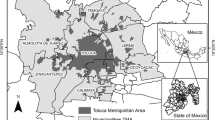Abstract
The structure of an urban heat island in the large industrial centers of the European part of Russia is studied based on the MetOp-A and MetOp-B satellite data. The intensity of the heat island is characterized by the different temperature and specific humidity between the urban area and the surrounding territory. It is shown that this analysis can be used only for large megalopolises like Moscow due to the limited horizontal resolution of the satellite data. The satellite data are grouped in time intervals of 19:30–23:30 and 10:00–13:00 UTC, called “evening” and “before noon” intervals, respectively. In the summer, Moscow’s heat island extends to ~1500 m. In the winter, the vertical extent of the heat island is ~1000 m before noon, and in the evening the heat island is recorded only in the lowest part of the profile. During the summer, the heat island is accompanied by an urban dry island that extends for a height of ~1000 m. Specific humidity increases above these heights as a rule. In the winter, a wet island is most pronounced above the surface.




Similar content being viewed by others
REFERENCES
Aires, F., Rossow, W.B., Scott, N.A., and Chédin, A., Remote sensing from the infrared atmospheric sounding interferometer instrument. 2. Simultaneous retrieval of temperature, water vapor and ozone atmospheric profiles, J. Geophys. Res., 2002, vol. 107, no. D22, pp. 4620–4631.
Alekseeva, L.I. and Myagkov, M.S., Heat imbalance of the active surface in Moscow under the influence of anthropogenic factors, Ustoich. Razvit. Nauka Prakt., 2004, no. 3, pp. 41–50.
Bornstein, R.D., Observations of the urban heat island effect in New York City, J. Appl. Meteorol., 1968, vol. 7, pp. 575–582.
Chandler, T.J., The Climate of London, London: Hutchinson, 1965.
Duckworth, F.S. and Sandberg, J.S., The effect of cities upon horizontal and vertical temperature gradients, Bull. Amer. Meteor. Soc, 1954, vol. 35, no. 5, pp. 198–207.
Gorod, arkhitektura, chelovek i klimat (City, Architecture, Man, and Climate), Myagkov, M.S., Ed., Moscow: Arkhitektura-S, 2007.
IASI Level 2: Product Guide, EUMETSAT, EUM/ OPSEPS/MAN/04/0033, v3B. 15 October, 2014.
IASI L2 PPF v6: Validation Report, EUMETSAT, EUM/TSS/REP/14/776443, v4C. 13 October, 2014.
Kadygrov, E.N., Kuznetsova, I.N., and Golitsyn, G.S., Heat island in the boundary atmospheric layer over a large city: New results based on remote sensing data, Dokl. Earth Sci., 2002, vol. 385, no. 6, pp. 688–694.
Kislov, A.V. and Konstantinov, P.I., Detailed spatial modeling of temperature in Moscow, Russ. Meteorol. Hydrol., 2011, vol. 36, no. 5, pp. 300–306.
Kolokutin, G.E. and Fomin, B.A., New spectroscopic databases and remote sensing of the Earth using high-resolution IR spectroscopy, Sovrem. Probl. Distantsionnogo Zondirovaniya Zemli Kosmosa, 2014, vol. 11, no. 3, pp. 278–287.
Kurbatskaya, L.I. and Kurbatsky, A.F., Mesoscale numerical model of urban heat island in a stably stratified environment, Interekspo GEO-Siber’, 2015, vol. 4, no. 1, pp. 165–169.
Kuttler, W., Weber, S., Schonnefeld, J., and Hesselschwerdt, A., Urban/rural atmospheric water vapour pressure differences and urban moisture excess in Krefeld, Germany, Int. J. Clim., 2007, vol. 27, pp. 2005–2015.
Kuznetsova, I.N. and Nakhaev, M.I., Seasonal features of the thermal structure of lower atmospheric layers in the Moscow megapolis according to microwave measurements of temperature, in 80 let Gidromettsentru Rossii (The 80th Anniversary of the Hydrometeorological Center of Russia), Vilfand, R.M., Ed., Moscow, 2010, pp. 389–400.
Landsberg, H.E., Klimat goroda (The Urban Climate), Leningrad: Gidrometeoizdat, 1983.
Lokoshchenko, M.A., Korneva, I.A., Kochin, A.V., Dubovetsky, A.Z., Novitsky, M.A., and Razin, P.E., Vertical extension of the urban heat island above Moscow, Dokl. Earth Sci., 2016, vol. 466, no. 1, pp. 70–74.
Martilli, A., Clappier, A. and Rotach, M.W., An urban surface exchange parameterization for mesoscale models, Boundary-Layer Meteorol., 2002, vol. 104, pp. 261–304.
Oke, T.R., Boundary Layer Climates, London: Routledge, 1987; Leningrad: Gidrometeoizdat, 1982.
Scherbakov, A.Yu., Meteorologicheskii rezhim i zagryaznenie atmosfery gorodov (The Meteorological Regime and Urban Air Pollution), Kalinin: KGU, 1987.
Uspensky, A.B. and Rublev, A.N., The current state and prospects of satellite hyperspectral atmospheric sounding, Izv., Atmos. Ocean. Phys., 2014, vol. 50, no. 9, pp. 892–903.
ACKNOWLEDGMENTS
This work was supported by the Russian Geographic Society (grant no. 12/2014/RGO-RFFI) as part of the State Budget Theme AAAA-A16-116032810086-4.
Author information
Authors and Affiliations
Corresponding author
Additional information
Translated by L. Mukhortova
Rights and permissions
About this article
Cite this article
Gorlach, I.A., Kislov, A.V. & Alekseeva, L.I. Experience of Studying the Vertical Structure of an Urban Heat Island Based on Satellite Data. Izv. Atmos. Ocean. Phys. 54, 1102–1109 (2018). https://doi.org/10.1134/S0001433818090189
Received:
Published:
Issue Date:
DOI: https://doi.org/10.1134/S0001433818090189




